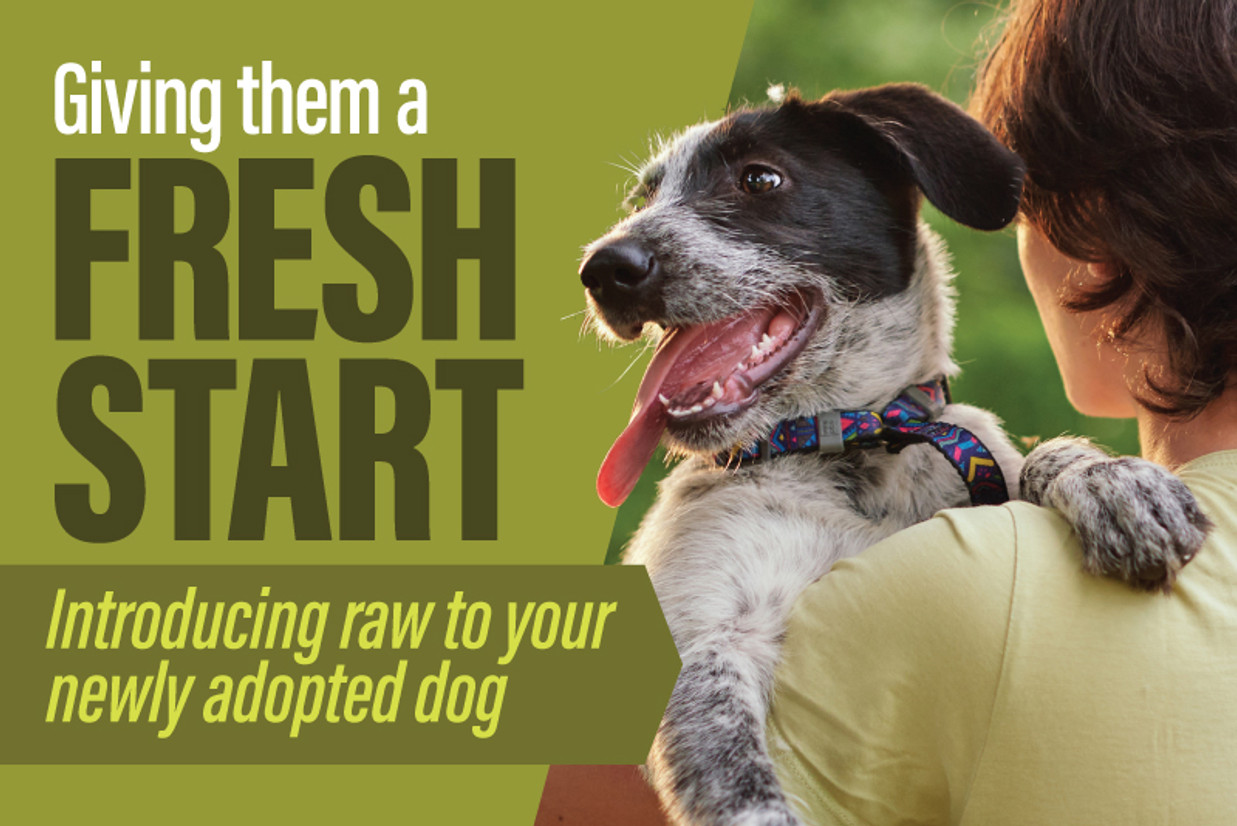Giving them a ‘fresh’ start
Where to begin with a raw diet for your newly adopted dog
You’ve just brought home your new rescue pup and are ready to offer them a brighter tomorrow! But where to start? Often you are left with an adult, senior, or adolescent dog that you don’t know too much about, especially when it comes to their previous diet.
The first few days in their new home can be a lot for them to adjust to: new people, sounds, smells, textures, environments, and expectations can all be a lot for them to navigate so it is important to take things slow and keep things simple – and that includes how we might introduce them to a new diet.
Many dog trainers, and rescue and shelter guardians use the 3-3-3 rule to make the transition to a new home environment easier. If you aren’t familiar, it states that generally it takes 3 days for a new dog to decompress, 3 weeks for them to adjust to your life and schedule, and then 3 months to finally feel at home. Although this rule is a great guideline it shouldn’t be taken very literally but used to understand that each pet comes into their new home with their own independent experiences, fears, and curiosities. The timing of each of these three comfort milestones will look different for each dog depending on their life history, personality and breed. Where they came from and even how far they have travelled to now be your new companion and family member can also factor in.
With all of this in mind, consider how they may take to the introduction of meals in their new home.
For some, everything can be very exciting and that includes what you serve, while for others it can be very confusing and new! Some dogs may enjoy exploring their new space and be too distracted to settle for a fresh meal. Others might be confused and hesitant to let their guard down for dinner. While others are just excited about their new surroundings, happy to be there, and ready for anything! Something to keep in mind in these first few hours and days, reluctance to eat might not be a matter of a fussy eater or a pet that doesn’t like the meal – but rather it might just mean that the pace is moving a little too quick for them, or things might be a lot more different than they’re use to.
Start Simple
Sometimes we are so excited to spoil our new dogs with all the treats, toys, and affection so they feel as excited as we are for their new start in life. But not every dog understands or appreciates all that excitement. Moving too quickly can lead to other issues, and too much too soon can sometimes also overwhelm a dog that is processing the new environment. Whether our new rescue is excited, unsure, exploring, or shy they are all experiencing a transition phase into their new home and with that comes a little stress too. Increased stress can have negative effects so when it comes to food, avoiding a flood of options and new tastes is best to reduce the risk of digestive upset or food aversion in those first few days.
Start Fresh – a “How To”
1) Stick to simple servings and simple meals
Start with a poultry Dinner recipe with no other supplements, treats, or toppers. Chicken Dinner, Turkey Dinner, and Duck Dinner are great recipes that are complete and balanced nutrition that require no supplementation and are easy to digest. This makes them a great introduction to fresh food for your new pup. Offer a small portion and gauge their interest in mealtime and their new diet, if they don’t lap up the bowl or take to their first serving, simply wrap up the dish and put it back in the fridge and try again at the next mealtime.
2) Digestive aids and supplements
Thrive Dehydrated Pumpkin Powder is a great addition to a new bowl especially for pups who were previously served kibble at the shelter or in their foster home. Pumpkin powder is a great source of soluble and insoluble fibre to help with the transition and helps replace some of the carbohydrates their digestive system is used to.
Thrive ProGut is a great alternative to pumpkin and offers a little more digestive support if needed or if no previous dietary history is known. This blend of pre and probiotics, along with fibre and digestive enzymes can really set them up for a healthy gut reset!
3) Take it slow
Some dogs might be thrilled with their new raw meals right from the get-go, and that is great! It’s still best to make any protein introductions gradually. This goes for bones, treats, supplements, and toppers. Introduce one new thing at a time, so you have an understanding of what works for your pup.
Don’t offer bones right away. It’s helpful to learn a bit more about your new dog’s chewing style, chew intensity, food drive, and play style before offering bones. A high food drive might indicate they could tend to guard resources. Food is often the #1 motivator for dogs so a bone is a high value reward. To be able to offer bones safely, you should be able to swap and take away the bone if necessary. Remember - all bones-chewing sessions should be supervised. Waiting until you have instilled trust in the relationship and done some training to have reached a point of knowing them is always a great idea before offering something too valuable.
Those first months together are for learning. Your new dog learning to be at home and comfortable while you start training, building that relationship, understanding their tendencies and quirks, and most importantly their favourite scratch spots and foods. Slow and simple introductions, food and otherwise, can not only help you understand their needs and preferences but can also allow them to settle in and enjoy all the newness of their great new life more quickly.
Recent Posts
-
Holiday Wellness Tips: A stress-free season for you and your pet
The holiday season is full of sparkle, excitement, and delicious food, but it can also disrupt your
-
Feeding Your Senior Pet: Supporting them in their Golden Years
Most raw feeding conversations revolve around transitioning puppies or adult dogs. Once the switch i
-
Catober Spotlight: Feline Favourites for a Healthier, Happier Cat
October isn’t just about pumpkin spice and cozy sweaters - it’s also the perfect time to celebrate o





